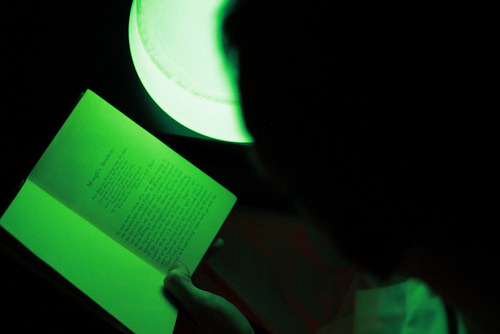The benchmark for bioluminescense has been set by the 2010 iGem team from the University of Cambridge. Look how bright they were able to make their bacteria glow - even reading by the light:`
You can read more about their project here: http://2010.igem.org/Team:Cambridge
We see no theoretical reason why we can’t get plants to glow as well as this in time. As George Church, Head of Genetics at Harvard Medical School, say’s in the video we shared yesterday ”to me it is paradoxical that we don’t have glowing fireflies and glowing everything that glows brighter than a flashlight. Biology is very energy efficient and energy packets are more dense than batteries”
So here’s the science behind how to plan to make a plant which glows more than the SUNY researcher’s plant. There are four key activities we will work on:
1. Codon optimization: There are 64 different codons (61 codons encoding for amino acids plus 3 stop codons) but only 20 different translated amino acids. The overabundance in the number of codons allows many amino acids to be encoded by more than one codon. Different creatures, eg bacteria vs plants, use different codons in different frequencies to code for the same proteins. One of our first goals will therefore be to adjust the bacterial designs to match the codon structure of a plant - this will boost the production of the proteins we want the plant to express.
2. Promoter selection: When a plant is reading the DNA it uses promoters to decide when to produce a protein. This is the mechanism by which a root cell knows to produce different proteins than a petal. Some promoters are active only at night, some respond to external stimulae and some respond to different aged plants. There’s even one which responds when a plant is cut meaning you could cut a leaf and have the plant glow along the incision, pretty cool! We have a long list of promoters to try and will try them in different combinations (eg should we make luciferin all the time and luciferase only at night… or both only at night?)
3. Metabolic engineering: What is the bottleneck of light production? Is it one of the enzymes that makes luciferin? Is it luciferase? Is it oxygen? Is it recycling of luciferin? Once we have a first glowing plant we will do experiments (eg manually add luciferin) to analyse which factors make the plant glow more, then we can boost that bottleneck to increase the overall reaction.
4. Gene copy numbers: Copy-number variations - a form of structural variation - are alterations of the DNA of a genome that results in the cell having an abnormal number of copies of one or more sections of the DNA. CNVs correspond to relatively large regions of the genome that have been deleted (fewer than the normal number) or duplicated (more than the normal number) on certain chromosomes. By experimenting with different copy numbers we can find a combination which optimizes the light production.
Source:http://glowingplant.com/

Comments